The word “AI” might sound a little overused these days. Artificial intelligence has become deeply embedded in every part of our lives, performing countless tasks across diverse industries. In many ways, we are already living in the futuristic cities we used to see in science fiction movies.
AI is no longer limited to the virtual world inside computers or smartphones. It now perceives, judges, and acts directly in the real world. Moving beyond generative AI systems such as ChatGPT and Gemini, Physical AI is emerging as the next major paradigm shift.
You might wonder, “Isn’t that just a robot?” Not exactly. Physical AI is not a robot that simply follows pre-programmed instructions. It is an intelligent system that can perceive its surroundings, learn on its own, and respond flexibly to environmental changes.
Let us take a closer look at how Physical AI is already operating in the real world.
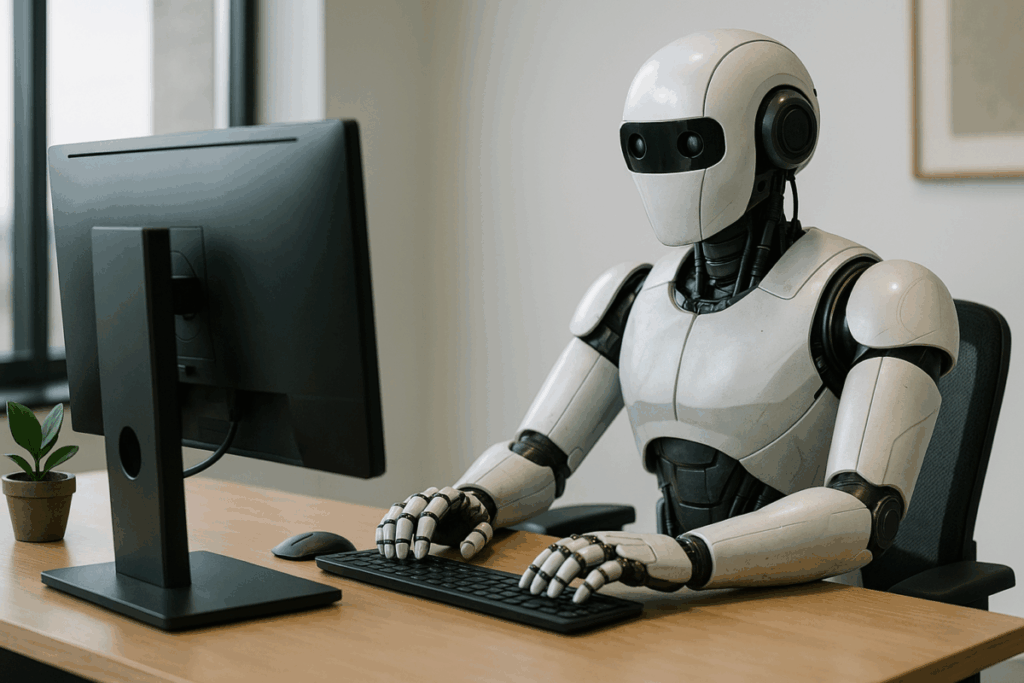
What is Physical AI and how is it different?
Physical AI refers to artificial intelligence that can think and act in the real world. Unlike digital AI that stays inside computers and smartphones, Physical AI can move and interact with its environment. ChatGPT, for example, communicates only through text and exists in digital space, while robots that move on their own and handle physical objects represent Physical AI.
The key difference is that traditional robots move according to fixed programming, whereas Physical AI can understand and adapt to its surroundings.
| Traditional AI | Physical AI |
|---|---|
| Exists only in digital environments (for example, chatbots, image analysis) | Operates in both digital and physical spaces |
| Processes text, images, and data | Acts and interacts in the real world |
| Provides information or predictions | Performs physical tasks |
| Requires human instructions | Acts autonomously |
| Example: ChatGPT, recommendation algorithms | Example: Tesla Optimus, logistics robots, autonomous vehicles |
In simple terms, traditional AI can “think,” while Physical AI can “think and act.”
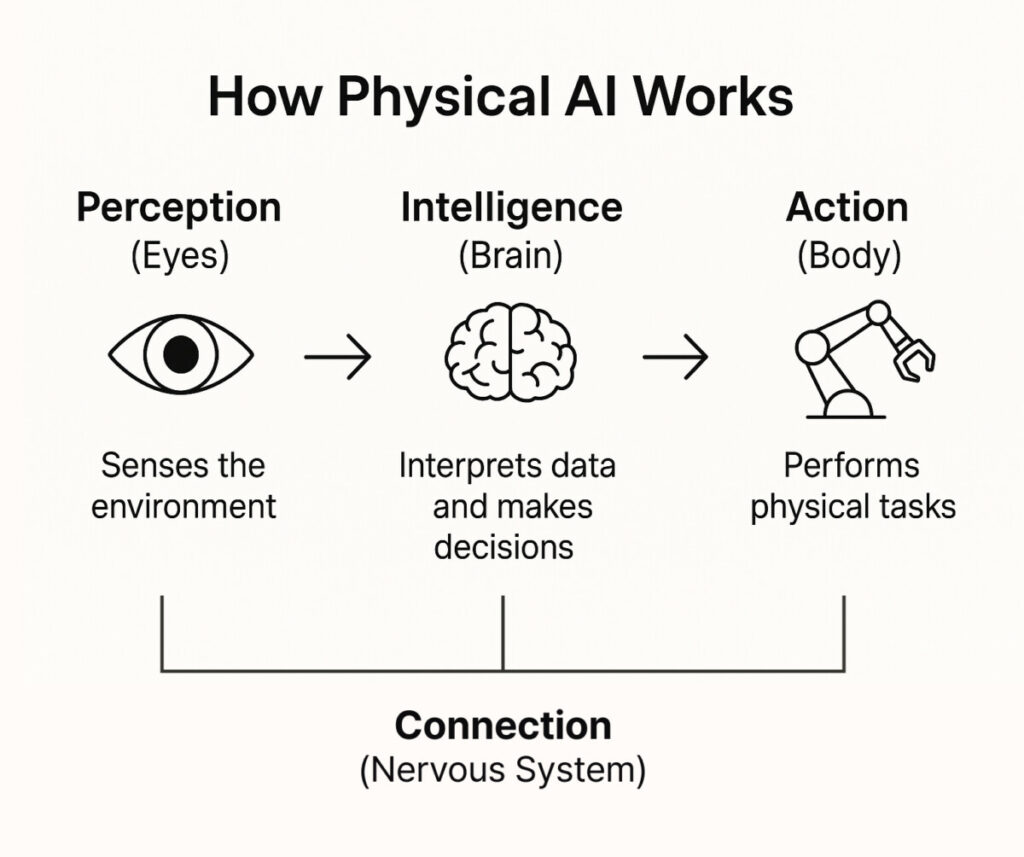
How Physical AI Works
The simplest way to understand Physical AI is to compare it with the way humans operate. We see with our eyes, make decisions with our brains, and act with our bodies. Physical AI works in much the same way, combining sensors, algorithms, and mechanical systems into one integrated loop.
1. Perception (Eyes)
Just as humans use their eyes and ears to perceive the world, Physical AI senses its surroundings through cameras, LiDAR, radar, and tactile or proximity sensors. These sensors collect real-time data about distance, speed, material, and risk. It is not just about recognizing that something is in front of it, but also how far it is, how fast it is moving, and whether it may be dangerous, much like how humans sense obstacles while walking.
2. Intelligence (Brain)
Once the data is collected, algorithms analyze and interpret it. Physical AI uses large vision-language models and reinforcement learning to make decisions. For example, a logistics robot may start out slow and awkward, but after thousands of repetitions, it becomes faster and more accurate, just like how people learn to ride a bicycle through practice.
3. Action (Body)
After making a decision, actuators, robotic arms, and drones perform the required movement. Balance, coordination, obstacle avoidance, and energy efficiency are all crucial for this stage, much like human muscle control.
4. Connection (Nervous System)
Finally, all these elements are connected through cloud computing, edge processing, IoT networks, and digital twin systems. This digital nervous system enables data exchange and synchronization so that many robots can work together as one coordinated network.
Physical AI repeats this continuous cycle of perceiving, deciding, acting, and learning, becoming smarter and more capable with experience.
Physical AI in Our Daily Lives
Although it may not be immediately visible, Physical AI is already being used in many areas around us. It is quietly changing how work is done and how cities operate.

Logistics and Distribution
The logistics industry has been one of the fastest to embrace Physical AI. Global companies like Amazon, Walmart, and Alibaba now rely on thousands of smart robots to move and sort products inside their warehouses.
Amazon first started with Kiva robots to automate simple transport tasks, which helped cut labor costs and speed up operations. Now, more advanced robots such as Proteus and Locus use AI and multiple sensors to understand their surroundings, plan routes on their own, and handle complex workflows with ease. By analyzing the space through LiDAR and cameras, these robots can work safely and efficiently all day long, keeping warehouses productive and running smoothly.

Manufacturing and Smart Factories
Manufacturing is the field where Physical AI is being applied most rapidly and extensively. Tesla plans to deploy its humanoid robot Optimus in factories to perform tasks such as transporting parts, assisting with assembly, and inspecting product quality.
According to a current Tesla expert (via Liahnson and Company),
“Optimus is currently gathering data by repeating fundamental movements such as walking and moving objects within the office. Through this process, we are testing how efficiently it can function in real work environments and preparing for large-scale industrial deployment.” – Expert currently working with Tesla
This shows that Physical AI is no longer an abstract concept. It is being actively tested in real-world conditions and gradually becoming part of actual industrial operations.
(If you would like to interview this Tesla expert or others directly, please click here to contact Liahnson & Company.)
Beyond Tesla, the Figure 02 robot developed by the California-based startup Figure AI is already working in real factory environments. Figure 02 is a humanoid robot that walks on two legs and uses both arms to handle objects with precision. It represents a new generation of Physical AI that can safely and effectively collaborate with human workers.
Healthcare
In healthcare, Physical AI supports both surgery and patient care. Johnson & Johnson’s Ottava surgical robot performs precise minimally invasive procedures, improving accuracy and recovery times. Caregiving robots are also assisting medical staff by delivering supplies and monitoring patients.

Smart Cities and Mobility
Physical AI is a core part of smart city infrastructure. Autonomous vehicles, drones, and robots move throughout urban areas, managing traffic flow and improving energy and environmental efficiency. In Tokyo and Berlin, AI-driven shuttles and unmanned delivery bikes are under trial, while in San Francisco, robotaxis are already operating commercially. In the agricultural sector, drones have become essential to smart farming, performing precise pesticide spraying, crop analysis, and automated harvesting.
Construction, Defense, and Disaster Response
Physical AI is becoming increasingly valuable in places that are too dangerous or difficult for humans to reach. In construction, unmanned excavators and autonomous transport robots help reduce the risk of accidents while speeding up work. In defense, AI-driven vehicles and reconnaissance drones carry out surveillance and patrol missions with precision. During emergencies or natural disasters, firefighting and rescue robots step in to extinguish fires, locate survivors, and support human responders. As technology advances, Physical AI is quickly evolving into a reliable partner that works hand in hand with people across critical industries.
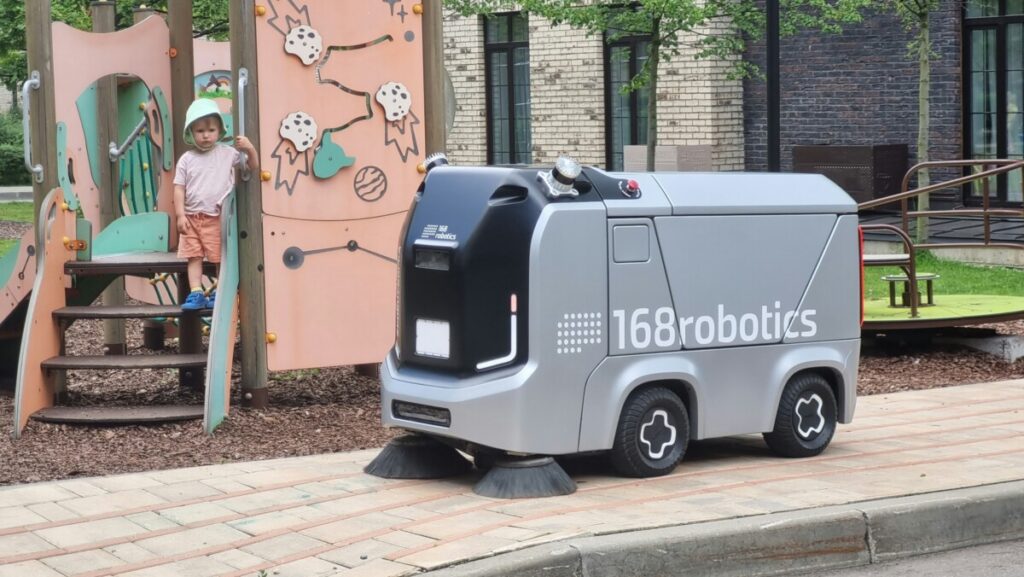
Global Strategies and Competition
United States
The United States is leading commercialization efforts. Under the Stargate Project, the government announced a 500 billion dollar AI infrastructure plan, building more than 20 large data centers nationwide. Major players such as Waymo, Boston Dynamics, NVIDIA, and Figure AI are driving advances in robotics, autonomous driving, and industrial automation.
China
China plans to invest more than 40 billion dollars by 2030 to create the world’s largest AI and robotics market. Over 450,000 smart robot manufacturers are operating, and companies such as Baidu, Alibaba, DJI, and UBTech are rapidly developing large-scale production systems across multiple sectors.
Europe
The European Union is investing 200 billion euros in AI and robotics through the InvestAI Project, emphasizing ethics, privacy, and sustainability. Germany and France are leading large-scale projects in smart factories, autonomous transport, and urban safety. The European robotics market is expected to grow by more than 25 percent annually over the next decade.

Challenges and Issues Ahead
Despite rapid progress, several challenges remain. The cost barrier is significant, as small and medium-sized enterprises often struggle with high setup and maintenance costs compared to large corporations.
Safety and technical reliability are also critical. Determining responsibility for accidents, ensuring data protection, and improving operational safety all require clearer regulation. In addition, issues such as battery efficiency, sensor precision, and the difference between simulated and real-world environments still need to be resolved.
Finally, labor market transformation is inevitable. Routine tasks will decrease, while new opportunities will emerge in AI management, data analysis, and robotics control. Preparing for this shift through reskilling programs and social support systems is essential.
The future of Physical AI will depend on achieving a balance between cost, safety, innovation, and human collaboration.
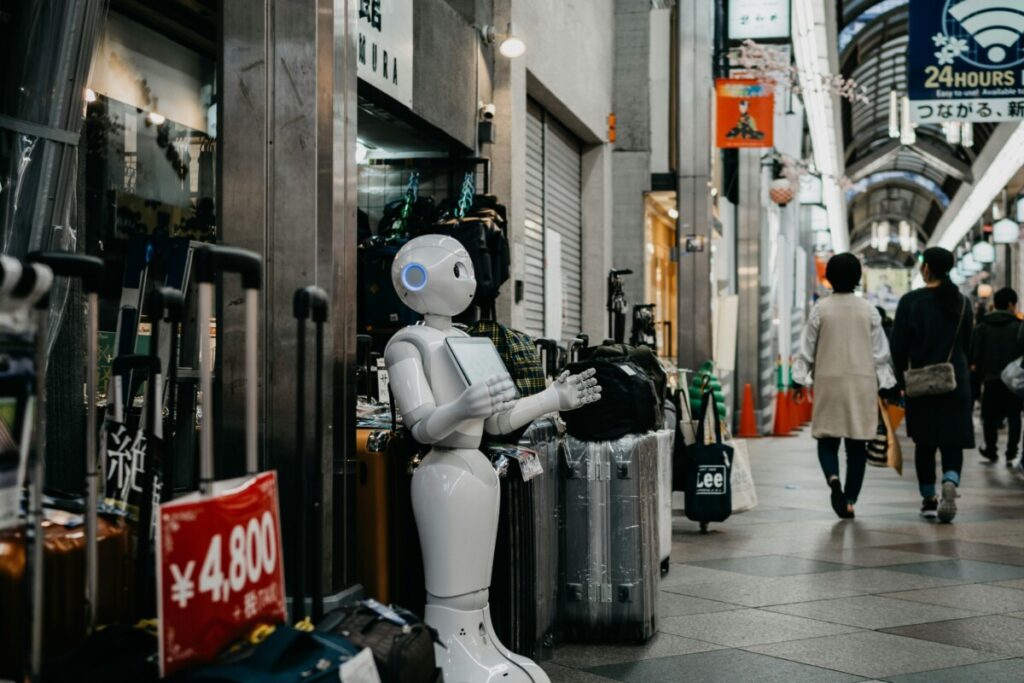
Future Outlook
Physical AI is becoming a transformative force across industries including automation, mobility, and healthcare. The global market, currently valued at 70 to 75 billion dollars in 2025, is projected to grow 20 to 23 percent annually, reaching up to 1 trillion dollars by 2030. Manufacturing is expected to account for more than half of this growth.
Advances in generative AI, edge computing, and low-cost sensor technologies are accelerating adoption, with leading companies such as Tesla, NVIDIA, Agility Robotics, and Boston Dynamics at the forefront of innovation. While challenges such as labor transition, energy consumption, and ethical regulation remain, global organizations including the World Economic Forum and McKinsey share a common view:
Physical AI marks the beginning of a new industrial era where humanity moves beyond its physical limitations.
The real challenge now is to ensure that this technology not only advances industry but also meaningfully improves human life.

Reference
https://appinventiv.com/blog/benefits-and-use-cases-of-physical-ai
https://spri.kr/posts/view/23873?code=data_all
https://www.causeartist.com/physical-ai-explained
https://www.bmwgroup.com/en/news/general/2024/humanoid-robots.html
https://biz.chosun.com/en/en-policy/2025/08/29/ID57DEXL6VFEFIZI6ACQXB5CSI

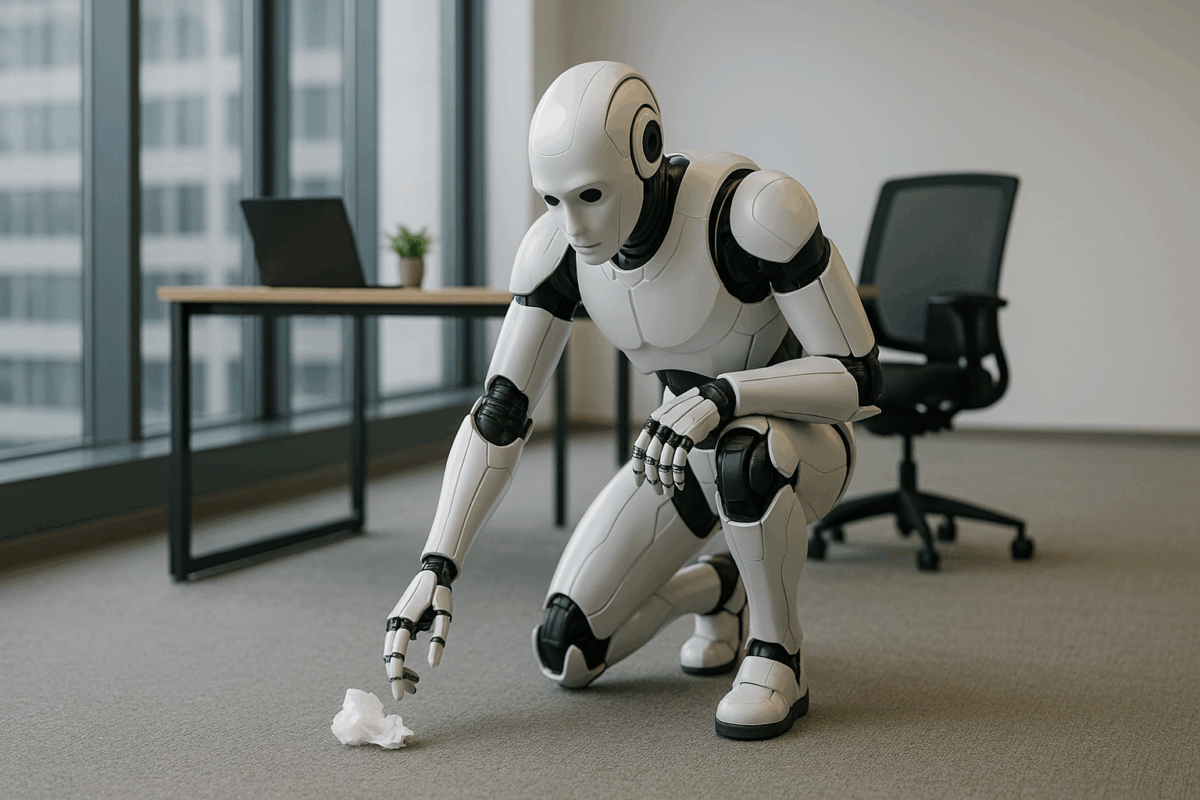
답글 남기기